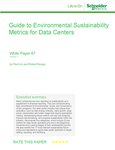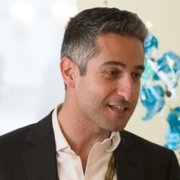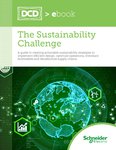In this article, we explore how a well known US government research laboratory is using a connected power management solution to help validate and improve power usage efficiency (PUE). This is helping them prepare today for the addition of new supercomputers, while meeting sustainability and resilience objectives into the future.
Moving data center sustainability forward
Though data center efficiency has progressively improved, the Uptime Institute predicts that ‘demand will substantially outpace the gains from efficiency practices over the next five years.’
Marc Garner of Schneider Electric recently noted that, as sustainability rises to the top of corporate and consumer agendas, “the data center industry is becoming increasingly accountable and has a key role to play in driving sustainable operations.” Under this lens, data center sustainability should be vigorously pursued, while still keeping operations running 24/7.
The US Office of Energy Efficiency & Renewable Energy provides a wide range of efficiency advice for data centers. In fact, the Department of Energy (DOE) supports other agencies and national laboratories in this effort through its National Data Center Energy Efficiency Information Program.
The program encourages best energy management practices – including the use of efficiency metrics and benchmarking. It also offers a certification process that recognizes best-in-class performance for new or existing data centers.
Achieving greater data center sustainability in challenging circumstances
One of the US government’s leading laboratories includes a large and secure supercomputing facility. This facility is used to perform a variety of modeling and simulation projects, under the direction of the DOE.
The supercomputer facility currently consumes more than 10 MW, but energy consumption is forecasted to increase by more than 20 MW when new next-generation supercomputers come online in a few years.
To prepare for this substantial increase, the cross-functional facility team – comprised of facilities, operations, sustainability, and utility personnel – wanted to find every way possible to improve the energy efficiency of the computing facility data center.
To better manage their energy use, the facility team needs to accurately measure it. Though already equipped with some sensors and meters throughout their power distribution system, there was still a lack of full visibility to overall energy use.
In addition, they had been spending a lot of time manually collecting energy data and calculating PUE every quarter. PUE – an industry-standard metric that compares energy consumption to overall data center energy consumption – is regularly reported back to the DOE.
This process was clearly not sufficient. To better understand and improve their efficiency, they needed data from more points, in real-time, to provide greater granularity and accuracy. And they wanted this data to be collected and analyzed automatically to reduce workload and avoid human errors.
Smart power management helps validate efficiency
The facility team chose an EcoStruxure™ Power solution from Schneider Electric. EcoStruxure Power Monitoring Expert software continuously captures energy consumption values from an expanded collection of smart energy meters, power quality meters, and circuit breaker trip units.
The system is configured to automatically calculate PUE on an ongoing basis, as well as track many other power and energy characteristics including power quality and energy efficiency
Using this new system, the team was able to validate that the yearly PUE of the computing facility was below 1.2, which is about 30 percent more efficient than the average data center. This meant that they were well on their way to meeting the data center sustainability and efficiency goals set by both the lab itself and the DOE.
Armed with these new intelligent analytic tools, the facility team was confident they could improve further.
Encouraging energy-efficient behavior, and proudly advertising success
The best way to get others to support your efficiency initiatives is to share the responsibility. The facility team had a vision to present energy-efficiency statistics to all maintenance and support personnel to help encourage efficient behaviors and generate ideas for improvement.
The team closely collaborated with the Schneider Electric engineering services group to develop a comprehensive custom-tailored, dynamic energy dashboard. The dashboard displays energy consumption broken down by computing, cooling, and office space, as well as PUE.
With this part of their program in place, the facility team then wanted to share their successes with the many prominent guests that visit the facility. Working again with Schneider Electric, a second customized and simplified dashboard was created to showcase sustainability performance in the operation center and visitor lobby.
Data-driven decisions enable continuous improvement
Active energy management means staying on top of performance while always looking for new opportunities to improve.
The new power management solution is helping the facility team to expose energy inefficiency and waste and then make data-driven decisions regarding which projects to prioritize to deliver the biggest impact.
Powerful visualization tools help analyze the types of loads that consume most of a facility’s energy. In this facility, it means cooling the supercomputers.
The computing facility cooling towers have been using almost three million gallons of water per month and running large energy-hungry cooling compressors.
The facility team can now easily calculate the PUE improvement that will result from gradually replacing computing equipment with alternatives that use warm-water cooling. Other opportunities are also being investigated.
These plans are also being shared with the DOE and other DOE National Laboratories. Not only will this help facilities teams work together to develop best practices, but it will also provide the ideal platform for this laboratory site to promote its achievements in meeting conservation and sustainability objectives.
With so many institutions competing for funding, this may help the facility team secure additional budgeting dollars to further their research and their efficiency programs.
Reducing risk of downtime and costly repairs
Of course, energy efficiency and sustainability are high priorities, but so is ensuring operations stay resilient.
The EcoStruxure Power solution provides extensive insights into critical power networks that help minimize downtime, confirm backup generators are running reliably, and optimize maintenance to get the most out of energy assets while saving money.
Advanced alarm management gives operations personnel early warning of risks, while power quality event analytics help quickly isolate problems. This includes identifying whether the source of a power anomaly was internal or external (e.g., a lightning strike near the facility).
To learn more about Schneider’s EcoStruxure solutions, click here.
More from Schneider Electric
-

Sponsored Data center design and build: Destined for digital
As 2022 draws closer will a digital drawing board be the new norm?
-

Guide to Environmental Sustainability Metrics for Data Centers
A whitepaper covering the different environmental sustainability metrics for data centers, and how to implement them in your own facility
-

Schneider sets out metrics for sustainable data centers
Scorecard tells you if you're a beginner, advanced, or a leader


